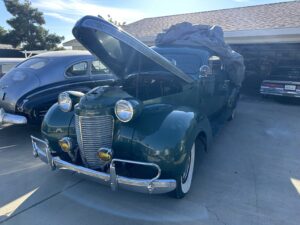
This 1939 Chrysler Imperial VIN Verification was done by our team member in Moreno Valley, Ca. on 10-11-2024

This 1939 Chrysler Imperial VIN Verification was done by our team member in Moreno Valley, Ca. on 10-11-2024
The 1939 Chrysler Imperial was a luxury automobile that epitomized the elegance and sophistication of pre-war American car design. Positioned as Chrysler’s flagship model, the Imperial was aimed at competing with other premium brands like Cadillac and Lincoln. For 1939, the Imperial showcased streamlined styling, improved technology, and more powerful engine options, making it a standout choice for those seeking high-end luxury and advanced engineering.
The Chrysler Imperial was first introduced in 1926 as Chrysler’s response to the luxury car market, designed to offer advanced engineering and high-end features. By 1939, the Imperial had evolved into a well-regarded nameplate known for its stylish design and technological innovations. Chrysler’s “Fluid Drive” transmission, introduced this year, made the 1939 Imperial particularly significant as it represented Chrysler’s commitment to advancing automotive technology. The Imperial also featured Chrysler’s commitment to craftsmanship and luxurious appointments, with the model serving as the pinnacle of their lineup before the disruptions caused by World War II.
The 1939 Chrysler Imperial was powered by a robust and refined inline-eight engine, offering respectable performance for a luxury car of the era:
The straight-eight engine provided smooth power delivery and excellent torque, making the Imperial capable of achieving relatively high speeds and offering a relaxed, comfortable driving experience. Though not a performance car by modern standards, the 1939 Imperial’s engine was seen as powerful and reliable, catering to those seeking a balance of luxury and performance.
The 1939 Chrysler Imperial embodied Art Deco-inspired design with streamlined curves and graceful lines, exuding an aura of prestige and sophistication.
Exterior Design:
Interior Features:
The 1939 Chrysler Imperial was offered in several body styles, each catering to different tastes and preferences:
These variants ensured that the Imperial appealed to a broad spectrum of luxury buyers, whether they sought a family car, a stylish convertible, or a formal town car.
Chrysler was known for pioneering automotive safety, and the 1939 Imperial was no exception. Though safety features were still limited in the pre-war era, Chrysler’s advancements in technology stood out:
Safety Features:
Technology:
The 1939 Chrysler Imperial, with its large straight-eight engine, was not designed with fuel economy in mind, but it provided decent efficiency for a luxury car of its size and power:
The 1939 Chrysler Imperial competed in the upper echelon of the American automotive market against other luxury brands:
While the Cadillac and Lincoln offered greater brand prestige, the Chrysler Imperial was more affordable while still providing high levels of luxury, style, and innovation.
In 1939, the Chrysler Imperial was positioned as a more affordable alternative to the luxury offerings from Cadillac and Lincoln:
Today, well-maintained examples of the 1939 Chrysler Imperial can fetch between $30,000 and $75,000, with rare or highly restored models potentially commanding higher prices in auctions.
The 1939 Chrysler Imperial didn’t receive any major awards at the time, but it is remembered for several key advancements:
The 1939 Chrysler Imperial remains a symbol of pre-war American luxury and innovation, with its blend of style, engineering, and comfort making it one of the most iconic models in Chrysler’s history.
Need a VIN Verification? We are licensed to complete the REG 31 form. Call to get your car, truck or motorcycle verified today!
© 2024 QUICK VIN VERIFICATION. All rights reserved.